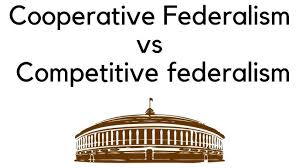Competitive and Cooperative Federalism:

The government has emphasized various initiatives to foster competitive and cooperative federalism and its benefits.
- Competitive Federalism is a system of horizontal (state-state) and vertical (Centre-state) competition to attract investment, improve governance, and enhance services.
- The 15th Finance Commission (FC) has introduced indicators like tax & fiscal efforts to evaluate state performance, that determines fund allocation.
- Examples of state-specific welfare schemes that operate alongside central schemes include:
- Rythu Bandhu (Telangana): A direct income support scheme for farmers.
- KALIA (Odisha): A farmer assistance scheme complementing the central PM Kisan Yojana.
- Vibrant Gujarat Summit: Focused on attracting global investment.
- Cooperative Federalism fosters Centre-state collaboration for effective governance, balanced development, and shared best practices.
- FC’s performance-based fund allocation encourages states to work in alignment with national SDGs.
- Key examples include the Goods and Services Tax (GST), Ayushman Bharat, and PM-KISAN, that require Centre-state cooperation.
- The All India Services (IAS and IPS) enable a uniform governance structure across states.
- The States Reorganization Act, 1956 established five Zonal Councils for regional cooperation, facilitating discussions on inter-state issues.




